Organisations must be prepared to react quickly and efficiently during a cybersecurity breach, system failure, or service interruption to minimise the impact on operations and customer satisfaction. An essential part of IT service management, incident management gives a systematic way to find, handle, and fix problems as soon as they happen.
Using the concepts and methodologies of ITIL Incident Management, this blog will discuss the best practices of incident management. Whether you’re an experienced IT professional or just starting with ITIL Courses, these best practices will help you handle incidents better and keep your business running smoothly.
Establish Clear Incident Management Policies and Procedures
Effective incident management is based on clear, lucid, well-documented policies and procedures. Determine who needs to know what, when, and how to communicate with incident responders, escalation points, and other essential parties.
To ensure that incidents are handled in a way that considers their severity and how they affect company operations, set up criteria for classifying and prioritising incidents. Organisations can simplify incident handling processes and guarantee consistency in response efforts by setting clear expectations and guidelines.
Implement a Centralised Incident Management System
Invest in an IT service management (ITSM) platform or centralised incident management system for more efficient incident capture, tracking, and resolution. Use the IT Infrastructure Library (ITIL) incident management technologies and tools to automate incidents’ logging, routing, and escalation so that they can be responded to and resolved quickly.
To make it easier for teams to work together and share information, ensure the incident management system is fully integrated with other IT service management processes. By consolidating incident management tasks, an organisation can significantly enhance its ability to see, coordinate, and control its incident response.
Adopt a Proactive Approach to Incident Detection and Prevention
Taking the initiative to find and stop issues before they happen is essential in incident management, as is the saying “prevention is better than cure” in general. Take a preventative stance in incident management by setting up monitoring systems to identify problems before they become big crises.
Keep a close eye on critical infrastructure, applications, and systems to catch any signs of unusual activity, performance drops, or security gaps. To lessen the chances of incidents, implement preventive measures like installing security patches, updating software regularly, and hardening the system. Businesses can lessen the occurrence and severity of incidents by taking preventative measures to deal with their sources and reduce risks.
Establish Effective Communication Channels
Successful incident management relies heavily on well-established channels of communication. Ensure there are well-defined ways for people to report, escalate, and share information regarding incidents. Ensure that those responding to incidents can communicate with each other and relevant stakeholders in real time using means like email, instant messaging, and collaboration platforms.
While responding to an incident, it is essential to have a plan in place for communicating with one another that specifies who is responsible for what, how to escalate the situation, and what protocols to follow. Organisations can keep stakeholders informed and involved throughout an incident’s lifecycle if they encourage open and honest communication.
Prioritise Incident Response Based on Impact and Urgency
An incident’s seriousness and time sensitivity should dictate the priority order for response operations. Put a framework or matrix for prioritisation that sorts incidents according to how they affect company operations and customer happiness.
Ensure critical incidents get resolved immediately by defining response targets and service level agreements (SLAs) for different types of incidents. Ensure that response efforts align with business priorities and objectives by allocating resources and prioritising tasks appropriately.
Establish Post-Incident Review and Continuous Improvement
Incident management doesn’t end with resolving the incident. To find out what went wrong, why it happened, and how to fix it, it’s crucial to review and analyse the incident after it happened. A formal procedure should be implemented to perform incident retrospectives or post-mortems to evaluate the efficacy of response efforts and find ways to improve them.
Look for patterns, trends, and recurrent problems in the incident data and metrics; they might point to systemic issues. Take steps to fix and stop the problem from reoccurring by understanding what went wrong. Organisations can improve their incident management skills and resilience to future incidents by encouraging a culture of continuous improvement.
Conclusion
Effective incident management must keep your business running smoothly and minimise interruptions. Organisations can improve their incident management and resolve incidents efficiently by following best practices. These include creating transparent policies and procedures, using a centralised system for incident management, being proactive in detecting and preventing incidents, creating channels for effective communication, prioritising response to incidents based on impact and urgency, and establishing processes for post-incident review and sustained improvement. Integrating these best practices into your incident management strategy can help you navigate and mitigate the challenges of incident response in today’s dynamic business environment, regardless of your experience level in IT.

